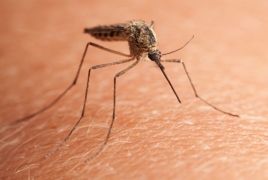Researchers work to create painless needles inspired from mosquitoes June 26, 2018 - 13:27 AMT PanARMENIAN.Net - Researchers at the Ohio State University are studying to mosquitoes in an effort to develop painless needles for medical purposes, Wkrn.com reports. “Mosquitoes must be doing something right if they can pierce our skin and draw blood without causing pain,” said Bharat Bhushan, Ohio Eminent Scholar and Howard D. Winbigler Professor of mechanical engineering at Ohio State. According to a release from the university, researchers are trying to replicate a mosquito’s ability to insert a needle-like probe into your skin and draw blood for several minutes without you noticing. For this study, the researchers extensively reviewed work already done by entomologists about mosquitoes, but with a particular focus. “We used our engineering background to characterize the parts of the mosquito to figure out how they may contribute to painless piercing,” said Bhushan. They used a technique called nanoindentation to probe how hard and stiff the tip of the labrum was in seven different places. They found that the labrum was softest near the tip and edges and became stiffer and harder farther in and up the labrum. “This is important because a softer and more compliant tip may cause less pain when it pierces the skin because it deforms the skin less,” Bhushan said. That was one of the four keys to painless piercing, according to the researchers. They identified the other three through their analysis of existing studies. Another key is the fact that the part of the proboscis that actually draws blood – called the fascicle – has a serrated design, like a saw. That may sound painful, but it is helpful because it makes for easier insertion. The fascicle also vibrates as it is inserted, which also helps lessen the force needed to pierce skin. Other research has shown that mosquitoes use an insertion force that is three times lower than the lowest reported insertion force for an artificial needle, which could be the result of the vibration and serrated design, Bhushan said. The final key to pain-free piercing is the mosquito’s use of a numbing agent. Once the proboscis is inserted, the insect releases saliva, which contains a protein that lessens pain. Based on these findings, Bhushan envisions a microneedle with two needles inside. One would immediately inject a numbing agent, while the second needle would draw the blood or inject the drug. This second needle, like the fascicle of the mosquito, would have a serrated design and be most flexible and softer at the tip and sides. It would also vibrate as it is inserted. Bhushan said that a microneedle like this would be more expensive than a traditional needle and probably could not be used for such needs as pumping intravenous fluids or drawing a large amount of blood. But it could be useful for children or adults who are particularly phobic about the use of needles. Authorities said a total of 192 Azerbaijani troops were killed and 511 were wounded during Azerbaijan’s offensive. In 2023, the Azerbaijani government will increase the country’s defense budget by more than 1.1 billion manats ($650 million). The bill, published on Monday, is designed to "eliminate the shortcomings of an unreasonably broad interpretation of the key concept of "compatriot". The earthquake caused a temporary blackout, damaged many buildings and closed a number of rural roads. Partner news |